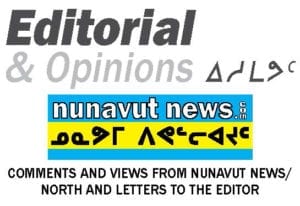Hunters and trappers organizations across the territory have been providing food for families in need with traditional Inuit country foods for many years now as illustrated in Rita Pigalak's article last week ("Country food program helps feed people of Kugluktuk," Nunavut News Feb. 24).
More than 100 families use the service in Kugluktuk every year and it is much appreciated by members of the communities, including elders.
This positive story peeks through decades of alarming food insecurity rates for Nunavummiut. Although the stats have been modestly improving – a reduction of 12 per cent over recent years with people experiencing food insecurity – the numbers are still staggering.

Around 57 per cent of households in Nunavut still experience food insecurity in some way, while their neighbours in the NWT sit at 22 per cent and the rest of Canada at 13 per cent ("New statistics show modest progress in stopping hunger in Nunavut," Nunavut News Feb. 24).
The federal government is taking this moment to attribute current improvements to the Nutrition North program, a Harper-era subsidies program that was aiming to increase the amount of healthy foods available in isolated communities at a subsidized price. The program has seen an increased amount of food being shipped North under the Liberals.
New subsidies for hunters have also been announced by the federal government, accessible through Nunavut Tunngavik Inc., which will be available in spring.
This last bit of info will likely perk the ears of Nunavummiut, but it's hard to estimate how widespread the impact will be felt.
Independent hunters and community groups such as the Kugluktuk HTO need to be encouraged and supported. They serve as an important part in solving at least some of the food insecurity issues in the territory.
A total of $30,000 per year – what Kugluktuk hunters are receiving – to help subsidize hunts and distribute food is not a lot of money relative to the needs of communities. How much more does the average bureaucrat in the territorial government or an MLA make in a year?
The Inuit had a job long before colonization came to their homes: to hunt and gather food for their families and community.
The needs of the people have not changed, but the prescribed means of doing so have. Perhaps the government could take a step and look for solutions right under their nose and fully fund organizations and community members to go out and harvest from the land. This would not come just in the form of paltry sums to be split among a few hardworking people, but creating jobs that truly employ the traditional knowledge and values of the Inuit people.
With politicians like John Main rightfully riffing against the territory's abysmal employment rates, getting people back out on the land to hunt and training new hunters could create several jobs for each community.
The Young Hunters programs in Arviat is currently doing just that, to much praise from people like Northern Affairs Minister Dan Vandal. The program is accessing a lot of federal funding across fixed terms, but these are the kinds of opportunities that need to be made permanent across all communities.
To give Nunavummiut access to good food, jobs, connection to tradition and dignity would be a large step towards securing their currently overlooked but rightfully deserved human rights.